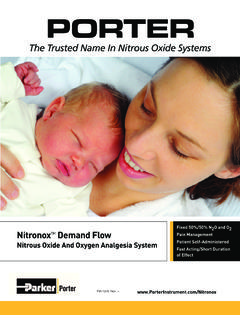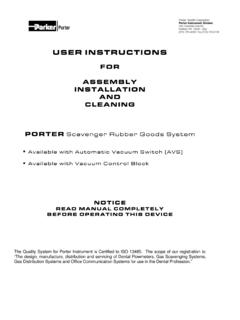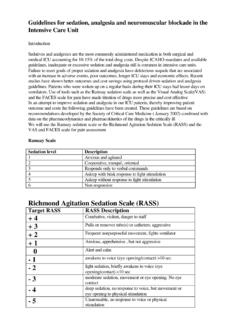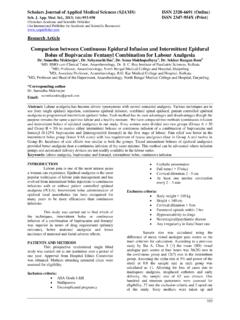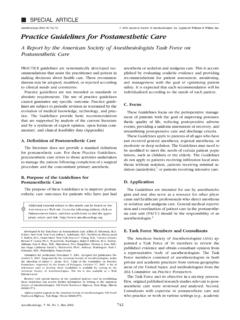Transcription of Nitrous Oxide Sedation Analgesia in a Phlebology …
1 Nitrous Oxide Sedation - Analgesia in a Phlebology Practice Thursday, 05/06/10 | 41443 reads Author(s): James W. Altizer, MD, FACPh, RVT, RPVI Since the operation the a strong affection for the gas-bag, and an earnest desire to retain it in his possession as the grand balm for the pains and trouble of this life. 1 1847 advertisement Phlebology has become primarily an office-based specialty thanks in no small part to the success of minimally invasive procedures, such as endovenous catheter ablation and microincisional ambulatory phlebectomy done under tumescent local anesthesia, which have largely replaced traditional vein stripping done under general anesthesia.
2 Tumescent anesthesia is not painless, however. Volumes of dilute local anesthetic of a few dozen cc s up to a liter in some cases are typically used for these procedures. A recent study found that patients treated with tumescent local anesthetic for varicose vein surgery found the procedure to be more painful than they expected. 2 Many Phlebology patients are needle phobic and express concern to the physician that they do not want to feel any pain whatsoever during the procedure. In fact, the fear of painful surgery and needles is sufficient to keep many patients from ever seeking care for a condition that is easily treatable.
3 Many practicing phlebologists who perform surgery employ oral sedative/anxiolytics, intravenous (IV) conscious Sedation , or a combination of the two. A few surgeons in Europe3 have used general anesthesia for these procedures, but studies show that local anesthetic is safe and Oral anxiolytics such as diazepam and alprazolam are quite safe and effective for mild anxiolysis when used in one-time preoperative doses in appropriate patients, but they provide no Analgesia . Conscious Sedation is also relatively safe in experienced hands, provided that appropriate intraoperative monitoring of vital signs, pulse oximetry and patient level of consciousness are done and appropriate reversal agents and resuscitation equipment are available for the rare case of excessive Sedation .
4 An ideal sedative/analgesic agent for varicose vein surgery would have fairly rapid onset of action, good therapeutic effectiveness, a wide safety margin, no drug interactions, quick recovery time, no hangover or excessive sedative effects, and would not require the presence of an anesthesiologist. One analgesic/sedative agent that has been available to the medical community for over 150 years and is used daily by anesthesiologists, dentists and some emergency departments is Nitrous Oxide (Figure 1). As will be outlined below, this agent, when used for varicose vein surgery, fulfills almost all of the criteria listed above, but unfortunately has been largely ignored, unused and untaught by anyone outside of general anesthesia or dentistry.
5 Clinical trials of Nitrous Oxide use as an adjunct to FM-1358 Rev. local anesthesia in dermatologic surgery were published in 1980,5 but widespread adoption of Nitrous Oxide usage is still lacking, perhaps because most non-anesthesiologist physicians have never seen Nitrous Oxide used and have never been taught how to use it. History of Nitrous Oxide Use Nitrous Oxide , the first anesthetic ever discovered,6 was first manufactured in 1772 by Joseph Priestly, an English chemist. Around 1800, Sir Humphrey Davy experimented with the gas and stated: As Nitrous Oxide in its extensive operation appears capable of destroying physical pain, it may probably be used with advantage during surgical.
6 7 The surgical world tragically ignored his suggestion, and interest in the surgical use of Nitrous Oxide would have to wait another half century. In Hartford, Connecticut, in 1884, a professor named Gardner Quincy Colton was making a living traveling from town to town giving demonstrations of the intoxicating effects of Nitrous . Present at one such demonstration was a local Hartford dentist named Horace Wells. Wells convinced Colton to come to his dental office and Colton administered Nitrous to Wells while his partner Dr. Riggs pulled one of Wells s teeth. The procedure was a resounding felt no pain at all.
7 He immediately began using Nitrous regularly on patients in his dental practice. The American Dental Association finally recognized Wells as the discoverer of anesthesia in 1864 and the American Medical Association recognized the same in Nitrous Oxide was used alone as an inhalational anesthetic until the 1860s when oxygen began to be administered simultaneously. Prior to that time, anoxic anesthesia was possible and not uncommon when patients were given only 100% Nitrous (Figure 2). Currently, available Nitrous Oxide /oxygen delivery systems are manufactured with oxygen fail-safe devices that stop the flow of Nitrous when the flow of oxygen is stopped, thus preventing this catastrophe.
8 Every year, approximately 45 million patients undergo anesthesia in North America, with Nitrous Oxide constituting a major component in about half of these A significant percentage of general dentists use Nitrous Oxide Sedation in their practices. Nitrous is the most used gaseous anesthetic in the world, commonly administered for the purpose of enabling a lesser amount of a more potent and usually more toxic general anesthetic agent to be It is available in fixed concentrations of 50% Nitrous /50% oxygen in some countries for use by paramedical personnel as prehospital treatment of the pain of acute myocardial Properties Nitrous Oxide is the weakest of the inhalant anesthetics.
9 It is commonly used as a carrier gas to facilitate the absorption and allow lower concentrations of more potent and toxic general anesthetic gases. It is an N-methyl-D-aspartate receptor antagonist with an experimental ability to block post-operative The chemical formula is N2O. It is colorless, nonflammable, with a slightly sweet odor. Nitrous Oxide has low solubility in blood, diffuses rapidly across the alveolar-arterial membrane and is excreted unchanged through the lungs. As a result, Nitrous takes effect rapidly and is quickly reversible on Nitrous Oxide can induce loss of consciousness at high concentrations, typically 70% or higher.
10 Nitrous Oxide produces either no change, or a slight increase in blood pressure, while all other volatile anesthetics reduce blood pressure. There is no effect on heart rate, but high doses may cause myocardial In 2002, the American Society of Anesthesiologists adopted guidelines for Sedation for non-anesthesiologists. The guidelines stress the concept of rescue, , physicians administering mild or moderate Sedation should have the skills and equipment necessary to rescue a patient should they reach the next deeper level of Sedation . Noteworthy is that these guidelines do not apply to patients who receive minimal Sedation defined as less than 50% Nitrous Oxide /oxygen alone, or a single oral sedative or analgesic alone in appropriate ,15 As will be seen below, however, many Phlebology patients will require doses of Nitrous of 50% or higher.
